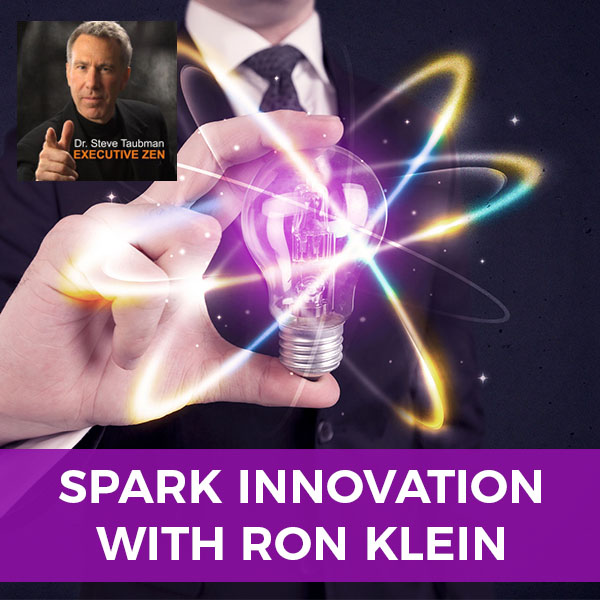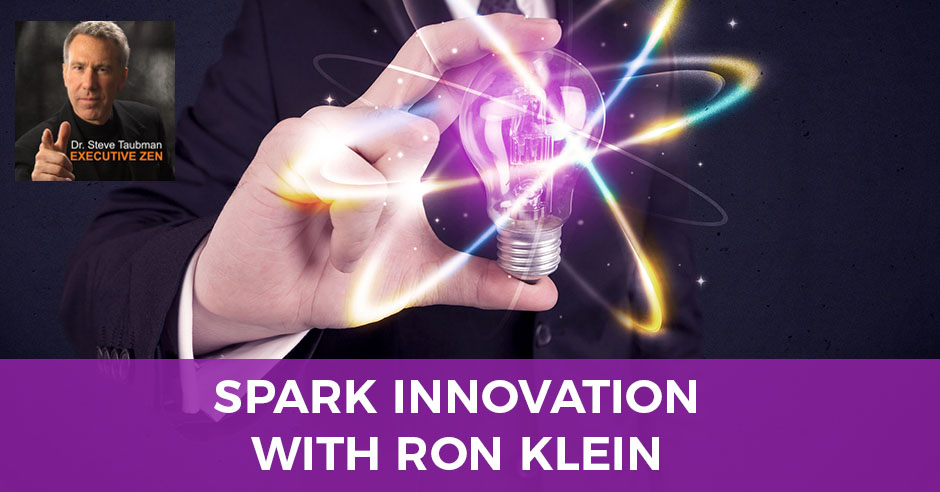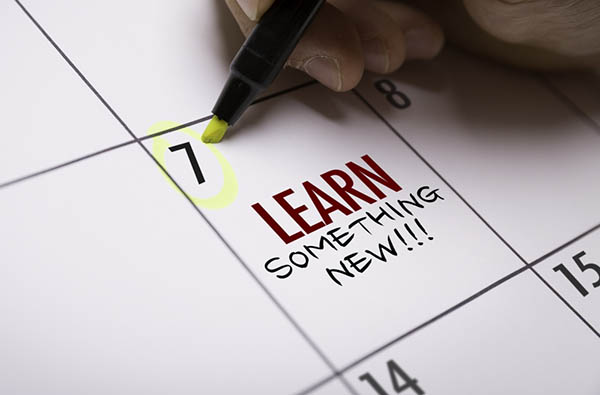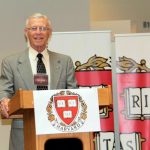

In this episode, I’m privileged to speak with The Grandfather of Possibilities, the legendary inventor, Ron Klein, about the art of innovation.
Ron shares incredible stories of his career, inventing the magnetic strip on credit cards, real estate MLS listings, and online bond trading technology. And he’s STILL inventing at 83!!!
What’s most relevant to leaders in this episode is what Ron has to say about the importance of innovating with a monetary benefit in mind. This will certainly help you to be more competitive in the marketplace! 🙂
—
Listen to the podcast here:
Spark Innovation with Ron Klein
Our topic is innovation. Our guest, Ron Klein, is one of the world’s leading innovators. The last episode, I issued you a challenge. I asked you to create a metaphor for yourself. As a hypnotist, I’m quite aware of the relationship between metaphor and reality. If you can clearly see your way of seeing something that you’re challenged by in the form of a metaphor, and then resolve it in the form of a metaphor. It can then have a profound impact on your ability to solve it in real life. I gave the example of seeing yourself as being stuck in the mud. What would it mean, in terms of imagery, for you to be stuck in the mud? What would it feel like? What would it look like? Rather than saying the words, “I’m stuck in the mud,” what would it feel to be stuck in the mud?
Imagine yourself creating some resolution for that. Maybe you could picture yourself putting a ladder into the mud or finding the walls of this hole that you’re in where you can climb out. Seeing yourself climbing out, you extend the metaphor from the metaphor of being stuck all the way to being a metaphor for the solution to being stuck. What we have discovered from the world of hypnosis, the world of the subconscious solution process, if you can create a metaphoric solution to your problems, you’re much more able to create solutions and get a sense of relief in your real life.
Here’s my rap on Zen and the art of innovation. I wanted you to get a sense of what’s on my mind around this area of innovation. It’s one thing to decide you’re going to be innovative and decide that you’re going to invent something. It’s another thing to do it and then to go off halfcocked and have no concept whatsoever of what you know or what you’re capable of. I was thinking back to my childhood. My friend, Mike and I, we fancied ourselves to be quite silly inventors. We decided we were going to invent something that would remove any stain from anything. We diligently, went about finding every liquid we could find anywhere around the house, whether it was oil, cleaning agent, alcohol, drinking or rubbing, and mixed it all together. We knew, therefore, that we had created something that was going to work well. We knew that confidently, so we used it on the family car.
It didn’t work that well. We removed a little bit more than the stains, but we figured, “That was the car’s fault,” and so we then used it on the laundry with not much better results. They say everyone wants to go to heaven, but nobody wants to die. In the same way, everybody wants to be Edison, but nobody wants to fail. We didn’t know what we didn’t know. We have to admit what we know and what we don’t know. These are my four rules of innovation. Number one, do you have a clear vision of the outcome? What are the solutions that you’re trying to arrive at? What is it that you’d like to accomplish? Do you know what that looks like if you get it?
Number two, do you have the knowledge to execute each of the steps in order to lead you to that? If you don’t have the knowledge, what do you need to do to get the knowledge? Number three, are you fearless enough to withstand setbacks? If you don’t have risk tolerance, then you’re not likely to work your way through to the ultimate outcome. Finally, do you have a method for measuring your success? We didn’t. Mike and I had no notion of whether or not we had achieved success because we were inventors. We already knew we were inventors because we put stuff together. We didn’t want to cloud our success with the fact that we weren’t, in fact, successful.

Spark Innovation: It’s an important question for business people to either grow, innovate, and solve or die
I’d love to hear some of your funny stories and anecdotes about trying to be an inventor. I’d also like to hear what’s worked in your business, in your life when you brought innovation and invention. What has it done for you? Naturally, it’s an important question for us, as business people, to grow, innovate, solve or die. We’ll be having a lot of fun with that question and issue with our remarkable guest, a legendary innovator and inventor. Hopefully, he’ll set me straight about my rap on Zen and the art of innovation. Am I making some sense here with these four principles? Do you have a clear vision of the outcome? Do you have the knowledge to execute the steps? Are you fearless enough to withstand setbacks? Have you got a method for measuring your success? You will be coming away with some ideas to improve your business, which must grow or perish.
—
I am thrilled to be introducing my guest. Ron Klein is an ordinary man who has accomplished extraordinary things. He’s a problem solver and his solutions have resulted in monumental change both in new inventions or simply strategic interventions for those in need. His innovative ideas have changed the world. He’s the inventor of the magnetic strip on the credit card validity checking system. He’s the developer of the computerized systems for real estate MLS listings, the voice response for the banking industry, and bond quotation and trade information for the New York Stock Exchange. In the way I understand it, he’s paved the way for us to be able to do online trading. In many ways, I believe Ron has tremendously changed our lives.
If that’s not enough for one lifetime, Ron’s latest patent at the age of 83 is for a device that enables a visually-impaired person the ability to identify an item when in physical range of that item. It utilizes a free smartphone app and special QR-coded adhesive labels. You’ve no doubt seen him on NBC, CBS, Huffington Post, or at a high-powered executive retreat near you. He’s a delightful man with a delightful wife, Arlene, both of whom are big lovers of my dog, Woody. I’m honored to know him and know Arlene and thrilled to be sharing him with you. Ladies and gentlemen, I give you the great Ron Klein.
Thank you so much. I’m glad you got my age in there, 83, but I’m still not empty. If you’re empty before you’re 83 that’s a sad story, but I’m not empty yet. I can prove it because I failed at retirement three times.
Even every success is a failure at some level. Click To TweetEven every success is a failure at some level.
My mantra is simplicity. I believe simplicity tremendously and that’s where most of the innovation can come from. We learned a lot from that in grade school when we tried to solve word problems. If you didn’t simplify it, you couldn’t solve it because it was full of so much useless information. In every problem, there’s a given and there’s a solution you’re looking for. Everything else in between is just a journey. That’s the minutia. Make sure that if you’re going to innovate, you don’t innovate with the minutia. You don’t start on the journey. You have to truly identify what’s the given and what’s the solution you’re looking for. I preface that by saying success, along with your word innovation is being smart, daring and different.
What do I mean by smart, daring and different? Smart doesn’t mean necessarily a PhD from Harvard. It means to be aware. Learn something new every day. Listen to everyone, you never know when you’re going to pick up some good information. It’s important to listen carefully and to be daring. If you’re not making mistakes, you’re not learning a thing. We learn from our mistakes. We don’t want to do the same thing over and over again making the same mistakes but don’t be afraid to make mistakes. If you painted it the wrong color the first time, paint it a different color. The last thing that is important and that word comes out in support innovation is, “Be daring and be different.” The difference is you don’t sell ideas, you sell benefits. Innovation and benefits go together. You’ve got to be smart, daring, and different.
When we talk about inventions, I don’t sit there in a think tank all day and say, “What am I going to invent today?” If a problem comes up, I turn it into challenges because a problem’s a frustration. I say, “Turn it into a challenge. There’s a gift behind every challenge and there’s an opportunity behind every challenge.” From that, you determine what the benefit is. It’s important to look at things as benefits.

Spark Innovation: There is a gift and opportunity behind every challenge.
I like the fact that you started out by reminding us about simplifying because that’s not the way we think about invention. We don’t necessarily tie the concept of the invention to the concept of problem-solving.
Here’s a good example. The easiest challenge I had in my entire career was the development of the magnetic strip on the credit card.
I need to pause a bit and have everybody absorb the reality of this. What you did, what you’re about to tell us about, which was simple, changed the world. There’s not a person who doesn’t take out a credit card, run it through a machine, and not think a second time about that. Talk about benefits, but tell us how that all came about.
If most people were there with me, they would have felt the same way. Here is the issue, a director of a large department store came to me and said, “We noticed that you are a problem solver. You can take a look at a challenge and come up with a solution.” Every month, the credit card companies would give the merchants a big, fat list of all the negative account numbers. It takes longer to process then because the merchant would have to look up that number to see if your number was in that big, long list. It was chronologically in order. They said, “The time it would take is slow and especially around at holiday time, it would back up the line.” The further problem to that was the burden was on the wrong person, it was on the merchant. It shouldn’t have been on the merchant. The process is too slow and the burden is on the merchant.
I said, “I’m going to simplify that. Let’s take all those negative account numbers that you give them every month, put it into some memory system.” Years ago, the memory systems were big, magnetic drums and so on. I said, “Let’s do a big memory system and then let’s give the merchant a little keypad and connect it to the memory system.” How simple is that? He keys in the account number because it was a little piece of plastic with POS name and the POS account number on it. He keys in the account number. If it doesn’t come up on the memory system, the person’s good to go. That was the first point of sale device. In 1964, I came up with this idea and in ‘66, started the development and the invention. I said, “This calls an issue of speeding the process up, but we need some way to put some smarts in that little piece of plastic.”
Right around that time, because I pay attention, listen and learn, reel-to-reel tape recorders came out. They were two reels and magnetic tape and you could record music, sound, and voice on it. It’s governed by two motors, so it’s constant speed. Otherwise, if it wasn’t constant speed, if you speed it up, it would sound like Mickey Mouse. If you slow it down, like Dracula. I said, “That’s pretty simple. I know how that works. If I take a little piece of that tape, record the account number on that little piece of tape, paste it on the back of the plastic credit card and make you the motor.”
Every opportunity is a challenge. Click To TweetI built a little device that mimicked the tape recorder. Here’s the little piece of tape on a piece of plastic. There’s a device that mimics the tape recorder. You are the motor sliding it through. People would say, “It’s not constant speed.” I put synchronization on there, start-stop synchronization. Once you put it in slow and put out fast, but once you swipe it, it would work. I innovated, I didn’t invent. Although it did come out to be an invention, I was innovative and saying, “I solved the problem.” The problem was speeding up the process, take the burden off the merchant, and put it on the person that should have the burden.
When you run a credit card through them fast, it sounds like Mickey Mouse. Is that how it works?
When you speed up the tape on a reel-to-reel tape recorder, it sounds like Mickey Mouse. The issue I had was everybody pushes it through the scanner and the feeder at different speeds. I wanted to make sure that I was detecting the data properly, so I had a start bit on the front and two stop bits on the back. Once you see the start bit, everything records the information. I don’t care how fast you slide it through. When you go to the end of the information, it says, “This is the stop. No more.”
That was the start-stop synchronization. I was a teletype expert years ago and that was the same synchronization they used on teletypes. In all of that, that put it on the little piece of tape. In this world of obsolescence where you’re lucky if something lasts for six months, I invented it in 1966 and I officially got the patent in 1969. Why did it stay all these years? What was the salvation? People would say, “I don’t know. I can’t imagine in this world of obsolescence.” Why did it survive since 1966? It survived as I thought about it being innovative, I said, “It doesn’t require energy. If it doesn’t require energy, it doesn’t radiate or transmit.” It was never fraudulence at the point of sale. If there was fraudulence, it was after the point of sale. It was at the server with a man in the middle. That’s why it survived all these years.
However, people say, “What about the chip?” That’s a whole different subject, I’m not an expert on that. There’s a lot of compromising with the chip. That’s a good sample as to simplicity. Identify the issue, simplify it and then come up with the innovation. It’s got to provide a benefit. If it doesn’t provide a benefit, it’s a hobby.
What did you think about my cleaning agent that my friend and I made to remove spots that remove paint?
You didn’t look at it as an innovative idea to solve a problem, you look at it as trying to invent something new, out of intellectual property that comes out of benefits. First, you have to look at it as will it provide a benefit? Don’t sell ideas, you sell benefits. From that, more and more concepts and ideas came to me through challenges that people brought. The MLS, the multiple listings, the national board of realtors came to me, the banking industry in the early ‘60s. Touch-tone phones just came out and I said, “Here’s a good idea. I can provide a benefit using the touch-tone phone to call up a remote computer at the banking operation.” After I was connected to the computer, remember that noise when you would be connected to an AOL? Connected to the computer, I could use the tones on the touch-tone phone as input to send my account number to the bank. The bank will take that account number, look it up on their computer, and then convert the account number to voice.
I built a big magnetic drum with three heads on it containing all the syllables of the language. What I would say was convert the text information to voice and you would get this voice coming back over your phone. That was the way to make an inquiry on your account in the banking industry. That was another idea. It went on and on and my company started growing quite large. I needed more money to house more employees and build more equipment. I had a private placement, raised a lot of money through the private placement, expanded and then needed more money for more equipment. We were up to 125 employees. I took the company public. I had an IPO, public offering, raised a lot of capital and the company became extremely successful manufacturing communication equipment.
Pay attention and be aware. Learn something new everyday and don’t be afraid to make mistakes. Click To TweetI was approached by a very large insurance company. They were interested in my company and I was approaching retirement age. I was 34 years old. I figured, “This is great.” I sold the company to this large insurance company and became their consultant. I started fishing. I fished for three weeks and said, “This is not me.” I was born in Philadelphia to a postal worker and my mom worked in a department store. I was born right after the depression and I said, “I’ve got to go back to work.”
That’s your first failure as a retired person?
Exactly.
What happened?
I figured, “I’ve got to do something.” I had no idea as to what I was going to do, but I didn’t want it to be labor-intensified with a lot of employees. I said, “Until I can come up with a good idea, I named the company General Associates. Maybe I’ll sell other people’s equipment until I come stumbling into a good thing.” That was when the innovation and the opportunities came about and I said to myself, “You have to look for an opportunity when it’s not obvious.” I started calling on the gentlemen at the Associated Press because I was going to try and sell some communication equipment. While I was talking to him and trying to sell him this equipment, I saw on his desk a bid sheet from Western Union. I asked, “What is this?” He said, “We’re in the communication business and Western Union puts up for bid every week with refurbished teletype equipment. We use that in our communications. We’re still overstocked. Feel free to take this bid sheet and go up through Allentown, Pennsylvania and talk to these folks.” I lived in Cherry Hill, it was close. “Talk to these people and see if you want to bid on some equipment.”

Spark Innovation: You have to look for opportunity when it’s not really obvious.
I went up there and I was in heaven because I was trained as an electronic engineer and a mathematician and I was sharp in communication. I figured, “I could bid on some of this equipment, I’ll be in the parts business. I like that.” I started bidding on equipment and they were in the process of putting up 12,000 old teletypes, in these steel cabinets that were used by AT&T and RCA. They were on battleships during the Second World War for communications. They put these 12,000 teletypes up and I figured, “If I buy those, I can use all those old parts, clean them up and start selling them for $0.50 on the dollar on all 12,000, pennies on the dollar.” What I didn’t do, and I wasn’t smart, I was the only bidder. I’m saying, “What’s going on here? Why am I the only bidder?” Needless to say, they were going into satellite business and that’s why they were liquidating all 12,000 machines. What an opportunity.
However, 4,000 were in a warehouse close by in Allentown, 60 miles from my home, “I can start refurbishing these. I’ll hire a technician, sell parts and refurbish them.” What I didn’t realize, 8,000 machines were all over the country. They were in Chicago, Texas, California, and Western Union says, “Ron, you realize you have to take possession of these within 30 days.” I figured I didn’t win teletypes, I inherited liability. I had to get rid of these things in 30 days, what was I going to do? I can’t start shipping them, they weighed hundreds of pounds, out of the country. What I did was I called the junk man. I figured, “I could make money on the 4,000.” I called the junk guy and this is when you have to look for an opportunity when it’s not obvious.
They came in and they said, “Let’s see what you’ve got here. You’ve got keyboards, printers, steel cabinets and then the bottom is loaded with electronics,” and I said, “That’s interesting,” and they said, “These machines are so old, the electronic circuit boards were made with gold traces.” I said, “What?” They said, “Yes, the resistors, capacitors, transistors, they’re all with gold traces,” because gold was great conductivity then and they were used out at sea on battleships. They didn’t want them to rust. They said, “If we take those circuit boards, submerged them in a cyanide bath. The cyanide will eat all the gold salts off. It’ll rise to the top. We’ll skim it off and we’ll split the profits.” I was fat in cash. Right around that time in the early ‘70s, gold went from $20 an ounce to $700 an ounce.
We made so much money on the gold, but I had 8,000 pieces of junk. No electronics, keyboards, printers, circuit boards, but steel cabinets. The junk dealer went back again and the junk dealer said, “Let’s look and see what we’ve got. These cabinets are rich in chromium,” because they didn’t want the cabinets to rust out at sea. He said, “There’s a foreign car dealer bringing their new cars into the country and they’ve got a terminal rust problem. They’re looking for anything that has chrome in them.” I gave all that stuff away to the junk dealer. The junk dealer gave it to this company in Japan. I was home free. What an opportunity to now be in the teletype business. The story gets better by reading a bid sheet on somebody’s desk and looking for an opportunity that wasn’t obvious. The opportunity was how you get out of a problem that I created? I still have 4,000 machines. I was now in the parts business.
Spot an opportunity and find a way in the door. Click To TweetThree months later, I get a call from the New York Stock Exchange. I was excited and they said, “We understand that you acquired all the machines that Western Union was liquidating and there were 273 special wall-mounted teletypes that we use as an inquiry station on the trading floor.” It’s now 1975, ‘76, “We’re interested in expanding operations on the trading floor. We would like to buy those machines.” I said, “I’ll give you a full payout lease over two years. You’ll own them after two years for nothing, as long as you give me a maintenance contract on the trading floor to maintain those machines.” They said, “Absolutely, we don’t want to fix them and maintain them.” I was now in the maintenance business on the trading floor of the New York Stock Exchange. I felt like a big deal.
Every day I would drive to New York and go to the New York Stock Exchange. I hired a technician and we’d run around the trading floor making sure those machines worked. If one didn’t work, we’d replace it with a spare and bring it back to my little shop in New Jersey, fix it, take it back. What a fantastic opportunity. I was making money in the maintenance business. I made money on the lease and all because I read a bid sheet on a guy’s desk.
How often are we attentive enough to spot opportunities? This is one that led to incredible amounts of riches. That’s not the end of the story yet either, is it?
No, because I simplified it and I said, “Pay attention, be aware.” I wasn’t necessarily the sharpest knife in the drawer, but I paid attention. I was aware. I’m learning something new every day and I wasn’t afraid to make a mistake. I turned that opportunity into a game. We were refurbishing some of those machines, selling them to the giant communication companies, and then selling the parts for $0.50 on the dollar.
In the teletype world, this was before email, everybody had Western Electric, which manufactured the teletypes. Western Union was a big customer of them. Everybody had their manuals and parts. I made an announcement to the communication world that I had parts, $0.50 on the dollar, in good condition because most of them were refurbished. They would look in their manual and say, “This is what we need for our maintenance.” They would order parts from me, ship them out UPS. What a great business. I had one technician.
While I’m on the trading floor of the New York Stock Exchange every day, I’m looking at this company, the New York Stock Exchange. They traded equity, stock and they traded fixed income, corporate listed bonds. The stock market was automated. They traded that upstairs. The bonds were still an auction market. They were throwing their hands up and down, talking on the telephone and trading. I was looking around at all these opportunities and I said, “This place trades like the government on inertia. It’s a bunch of little pieces of paper on the floor.” At the end of the day, the paper was unneeded. I went to them and I said, “You’ve automated the stock exchange, you’ve got program trading, and you’ve got all this other stuff. What about automating the futures exchange and the bond market?”
They said, “Ron, it won’t work. I know you probably know how to do it. You can build little computers and filter boxes, but they’ve been doing it like this for 205 years. They’ve been trading in an auction market for 205 years. Forget it.” I said, “I can’t forget it. If I can build a system that could enable them upstairs trading at their desk, just like they do in equities, would you be an exclusive license to the seven, eight corporate listed bonds for the New York Stock Exchange?” They said, “Yes because it’s not going to happen. 205 years they’ve been doing it this way. They’re not going to change. You’ll never be able to sell bond traders.” There were about 1,500 very active corporate-listed bond traders. They were trading quite a bit of money each day.
I took this little computer box, I built it as a filter, and I put it on the main line that the New York Stock Exchange had. They had options, hedge funds, equity and bonds. I put it on that line while a little video terminal hooked it up to the filter with a keyboard and I’m watching the bonds come out. I’m filtering only bonds, no other information. I can then enter and buy and sell orders in there and it worked. I started making phone calls to all the bond traders. In five seconds, if I wasn’t buying or selling a bond, who are you to hang up on me? I built this great box and maybe the exchange was right. They’re not interested.
A good mentor does not tell you what you want to hear. They tell you what you have to hear. Click To TweetI befriended the biggest bond trading manager on Wall Street for the largest specialty firm. I said, “I’m going to run a leased telephone line into your office. I’m going to give you a little box with a video terminal and you’re going to be able to see those bonds milliseconds before they get it on the bottom trading floor because they’re working over telephones. Will you allow me to do this?” He said, “You’re a pretty sincere guy. Yes, I have nothing to lose.” I said, “I’ll give it to you for free for 30 days. I’ll pay to run the line in and everything.”
I did that. He stopped at everybody’s bonds. His phone rang off the hook about a week to two after I installed it. They’re saying, “Joe, what the heck are you doing? We can’t buy or sell a bond. You’re topping every bid.” He says, “You need one of those little Ron Klein boxes.” They said, “What the heck is a Ron Klein box?” “He runs a telephone line to your office and he puts this little box in. You have a video terminal. You don’t even have to get down to the bottom trading floor.” They said, “How do we get this?” “Let me give you Ron’s number.” My phone rang off the hook and they’re saying, “We need one of these Ron Klein boxes.” I said, “It’s a bond trading system box. However, I’m building this whole big network and there are 1,500 of you out there. You’ve got to join my club for $10,000, one-time payment.” They said, “You’re out of your mind, but we have to have this box. We could probably make that back in less than a month. We’ll do the deal.” I collected $10,000 from 1,500 traders. Do the math.
Where did all this come from? A guy’s bid sheet on a desk that I was trying to sell him some communication equipment. I’m there and I’m collecting all this money and I said, “We’ll start installing these boxes. It’s going to take me about 90 days for 1,500 boxes, but you’ve got to buy the box.” They said, “No, you’re wrong. We don’t buy anything on Wall Street. We only rent the equipment.” The box cost me $100 to build. I said, “How’s $300 a month?” “Fantastic, we love it.” It was in for a quarter of a century providing transparency. That was my start on Wall Street and the corporate-listed bond marks. I was billing 1,500 units at $300,000, $475,000 a month, which I bought for nothing for a little box that I built. That grew and they had such great confidence in me. I started building it for the Amex, for the Philadelphia Stock Exchange, Comex and CBOE. I started building display equipment for the Treasury market. My company grew quite large. I was in that operation for 36 years.
Our audience are leaders, they’re executives. How important is innovation, invention and creativity in a business? You’re a business leader. Is this something that’s a nice idea or is this something that everybody needs to be doing?
What did it provide? Smart, daring and different. What’s different? You don’t sell ideas, you sell benefits. When they first started using the system and using the manual operation, they were trading $100 million a day. They’re trading yield to maturity and so on and so forth. When I finished on Wall Street, the corporate-listed bond market was $20 billion a day.
Smart, daring and different is huge. The idea we’re tying things to benefits. What is the problem we’re trying to solve? Ultimately, what are the benefits of having solved that problem? What I hear in your conversation is another lesson, which is confidence. There were times in your process where you had to be more confident about something than the people you’re trying to sell. You’re trying to break people of a traditional way of doing things. In their mind, there’s no reason to change. They don’t see it, but you’re seeing something bigger. You’re confident enough to say, “I spot an opportunity here and I’m going to find a way in the door.”

Spark Innovation: Be more confident when you’re trying to sell something new because you are asking people to break from their traditional way of doing things.
When you say door, I look at every opportunity as a challenge. I say every challenge that’s going to provide a benefit is a big room and it has a front door. I say before I open that front door and walk in and close it behind me, I look around at this big room of opportunity and I look for a back backdoor. If there’s a back door, what’s my risk? Failure’s not an option, so I close the front door and I say, “If it doesn’t work out, I leave through the back door.” There’s only plan A and that’s the opportunity. You have to have that can-do attitude and it’s there. It’s common sense if you could simplify it, identify it. I always say that when I’m dealing with someone, I refuse to have a battle of wits with an unarmed person. I’ve got to arm them. I’ve got to somehow convey my concept, my paraphrase of the idea to them in some level that they can understand and then I say, “We’re both on the same page. Let’s talk about the benefits. What are the opportunities?” Sometimes the opportunities are not obvious. You have to put those in some form where you see a benefit and that’s the way I work.
Do you teach innovation, problem-solving to groups?
Yes. When I failed retirement from the second company, I started consulting innovation, strategic planning. A good mentor doesn’t always tell you what you want to hear, they tell you what you have to hear. I mentor a lot of people. I’ve met a lot of projects. I’m a technical guy, but I have technical people coming to me. I’m sharp in intellectual property because I’ve patented a lot and I’ve written a lot of provisional patents for clients. Most people go to the technicians first before they go to the entrepreneur. The technicians are attorneys, surgeons, doctors, they’re all kinds of people that are competent in their field, but they’re not necessarily innovators and creators. Before you take your function to be implemented to them and they do a wonderful job in taking you through the patent process, you’ve got to vent the project and then take it to the attorney or take it to the surgeon and say, “This is my problem, let’s fix it.” That’s how I work. I help quite a few people that way. I spend most of my time speaking and that’s my marketplace where I show them how I can help them simplify, understand, and innovate. They come to me and I become their consultant or mentor and their innovator.
It appeals to that part of me that wants to be clear, precise, and cut-through all the bull and figure out what’s the problem? What’s the clearest and most effective solution that’s going to get us the results and the benefits we want? That’s not the technician’s job, that you have to become a technician or have a technician on board, but there’s a bigger thinking that’s happening here.
If you’re going to form an LLC, an S Corp, a C Corp or a benefit corp, that you’re going to structure an organization before you blew to the corporate people that can take you through the process, right operating agreements, and keep you safe in every area. You have to understand what the options are. I wanted to throw one last thing in and that was the innovation of trying to help someone. I had this device for the visually-impaired.
One day, I was having breakfast with a dear friend of mine who’s blind who ended up being an Executive Vice President for AT&T. He was blinded in high school through a chemical explosion. I sat down with him and I said, “Jim, what’s on your wish list?” He said, “Ron, we’re both creators and innovators and so on. I would love something simple that could help me identify the things I come in contact with my daily life. My clothing, spices, prescription drugs and so on and so forth.” I said, “Let me think about that.” Quickly, I went home and I had learned something new. This was in ‘95, QR codes came out. I came up with this idea of, “If I can do something special with QR codes and then come up with a free app that would go into a blind person’s phone.”
Go be responsible and healthy so you’d never be a burden to anyone. Click To TweetEvery one of them has an electronic leash. They all carry phones around. I came up with a little book of these little, adhesive, special QR codes that they can paste on anything they want to identify. Point the phone at it, educate it and it worked beautifully. They’re able to identify everything. They go to a supermarket, buy a jar of peanut butter, put the sticker on it, point their phone at it and say, “This is my peanut butter. This one expires.” They’re identifying everything they have or if they want to know what’s in the box. They want to identify things like that. It worked out well. I was able to put together these little labels in a book of 100 for less than $20. What blind person wouldn’t invest $20 to use a free app on their phone to be able to identify what’s on their hangar, what’s in their pantry, what’s in their medicine chest?
We launched for proof of concept to see if it would work. My whole purpose is to help my friend and a few others that would be wonderful. I discovered that there are 240 million blind people in the world, 42 million are right here in this country. We built the app. Apple was kind and helpful, they advertised it. We launched and the following day we had hundreds of people all over the world coming in and acquiring those little stickers. It solved their problem, and then we took it further and further. The name of the app is Envision ELI. ELI was the blind profit that read the Bible in Braille, that’s why I named it that. They can go to the website and take a look at it. It’s EnvisionELI.com. My website, if they’d like to learn a little bit more about me and everything that I’ve done, all they have to do is go to TheGrandfatherOfPossibilities.com.
There’s this wonderful quality that you’re sharing with us that’s not only magnanimous and helpful to the universe, but also it’s helpful to you. You’re showing us that this is a business model. If you’re a good problem solver, if you could simplify, if you can be smart, daring and different, then you could take these solutions and leverage them into a successful life and a successful business.
Learn something new every day. If you’re aware, you can simplify and adapt that to a challenge.
Any other final words?
Be responsible and healthy to yourself so you’re never a burden to anyone. Keep working until you’re empty. Retirement is not in my vocabulary.
Ron, you’re an inspiration. You’re a great guy. It’s an absolute pleasure to have you here. Thank you very much for joining me.
Thank you so much, Steve.
Take care, Ron. To learn more about Ron and find out how to bring him to your business, get him to teach your team to think creatively, you can visit TheGrandfatherOfPossibilities.com. This is a great pool to be swimming in to learn and understand what it is that he’s sharing.
If you’ve enjoyed the show, please send your comments to SteveTaubman@Gmail.com. Feel free to suggest a topic that’s particularly meaningful to you. Your host is an author with a deep knowledge of mindfulness, positive psychology and communication. I’d be happy to draw on my 30-year career and rather large Rolodex to bring you shows and guests that are most relevant to your needs. If you’d like to learn how to bring me to your company to create a mindful, holistic organization of fearless leaders, contact me at SteveTaubman.com.
I always like to end my show with a metaphor, a quote, and a challenge. The metaphor for this episode goes back to my story where I hypnotized somebody into thinking they’re stuck behind an invisible wall. My question for you is, “What’s your invisible wall?” That’s the metaphor. What would it take for you to move through that wall? What innovation? What new thinking? What creativity can you apply? Can you be more smart, daring or different as Ron talked about in order to break through your wall and achieve success?

Spark Innovation: Learn something new everyday, and if you’re aware, you can simplify the challenge.
I decided on three quotes for today. One is from Einstein. He says, “We cannot solve our problems with the same thinking we used when we created them.” The second one is Benjamin Franklin and he said, “Many people die at 25 and aren’t buried until they’re 75.” Ron is a great example of somebody who’s using his life to the fullest personally and professionally, for which we thank him. Edison said, “To invent, all you really need is a good imagination and a pile of junk.”
Here’s my challenge for you this episode. Go forth and create. Solve one problem in an innovative way and be willing to fail your way to success. When we return, my guest will be one of the greatest entrepreneurs, speakers, and humanitarians in recent history. He’s the Founder of Priceline, a Hollywood film producer, and winner of several international business awards, Jeff Hoffman. Jeff is also the coauthor of a book called The Power Of Wonder. Share this with your friends, subscribe to my podcast on iTunes and find my channel Executive Zen. Remember to live consciously and profit responsibly.
Important Links:
- Ron Klein
- EnvisionELI.com
- TheGrandfatherOfPossibilities.com
- SteveTaubman@Gmail.com
- Priceline
- Jeff Hoffman
- Executive Zen on iTunes
About Ron Klein

Ron Klein is an ordinary man who accomplishes extraordinary things. He is a PROBLEM SOLVER. Every solution has resulted in monumental change, either in a new invention or a simple solution. His innovative ideas have changed the world. He is the inventor of the Magnetic Strip on the Credit Card, Credit Card Validity Checking System and the developer of computerized systems for Real Estate (MLS) Multiple Listing Services, Voice Response for the Banking Industry and BOND Quotation and Trade Information for the New York Stock Exchange.
Ron‘s latest patent is for a device that enables a visually impaired person the ability to identify an item when in physical range of that item. It utilizes a smartphone and special coded adhesive labels. Visit www.EnvisionEli.com for addition information and to download the free app.
He was the founder and CEO of his public company, TECHNITREND, INC.
He was the founder and CEO of his company GENERAL ASSOCIATES, INC.